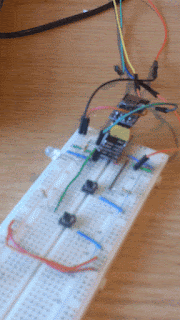EAGLE useful tips
Eagle is a pretty useful piece of software for designing circuit schematics and PCBs. I don't use it often enough to get really good at it however, and there are certain things in Eagle that I find myself having to "google" every time I want to do it! So without further ado, this is my growing list of Eagle tips, in no particular order:
RIPUP @;
and the ground plane will revert back to a polygon!
For my ATtiny Mario project, I had PCB buttons where the two halves are connected when a button is depressed onto them. I had problems initially as the ground plane was flowing into the part, and so button presses where connected Vcc to GND and causing all sorts of problems! The way to prevent this is to add a rectangle on the tRestrict layer in the part and... hey presto! No ground plane where it's not wanted!
(1) Ground plane polygon un-fill
Probably my number one this one - you've put in a ground plane polygon as a final step on your PCB, but you need to undo or un-fill the ground plane polygon to make some adjustment. Just type:
and the ground plane will revert back to a polygon!
(2) No solder mask over traces
The solder mask is the thin lacquer-like layer for protection against oxidation or solder bridges. Sometimes you need to have pads or vias without solder mask over them. Mostly this is already built into parts in Eagle. However, I had a recent case with a custom part, where I need to remove the solder mask. It is straightforward, draw a polygon or shape on the tStop layer on either the part or the PCB itself and the solder mask will not be present in the final board!
(3) No ground plane in-fill
A ground plane is always a good idea in a PCB, but sometimes you don't want it everywhere. You can restrict it by drawing a polygon or shape on the tRestrict layer.For my ATtiny Mario project, I had PCB buttons where the two halves are connected when a button is depressed onto them. I had problems initially as the ground plane was flowing into the part, and so button presses where connected Vcc to GND and causing all sorts of problems! The way to prevent this is to add a rectangle on the tRestrict layer in the part and... hey presto! No ground plane where it's not wanted!




Comments
Post a Comment